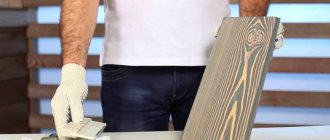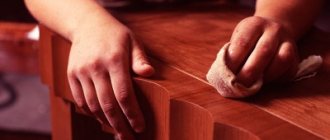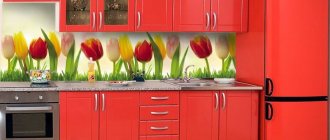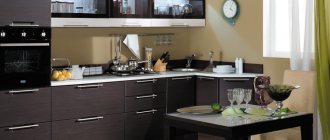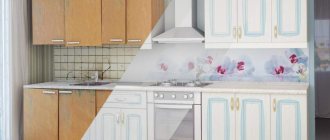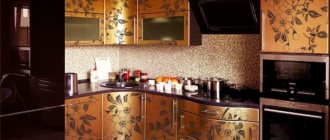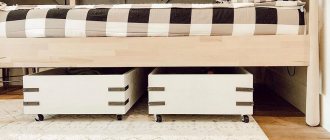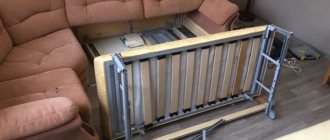Most home craftsmen or professionals involved in the independent manufacture of furniture, as individual entrepreneurs, know very well that they cannot do without a certain minimum of specialized tools.
Of course, for the production of small batches you will not need expensive stationary equipment intended for professional use, however, it is at least stupid to start cutting out the body parts of a kitchen pencil case when I only have a hand saw at my disposal.
To independently manufacture furniture products in a small workshop or garage, you need a certain tool arsenal, the cost of which can pay off after the manufacture of the first few cabinets, cabinets or pencil cases. Those for whom wishing is a hobby usually do not pay special attention to issues of payback and are ready to purchase an expanded set for their convenience. Let's look specifically at what you need to have on hand first, grouping all the tool items into categories.
Hand tool
The set of hand tools includes not only specialized accessories necessary for performing various operations in the manufacture and assembly of furniture, but also tools that are useful for performing other types of work.
This category should include:
- a tape measure with a measuring tape length of 5.0 meters, which can be fixed permanently;
- to mark the right angles of doors and parts of furniture cases and pencil cases, you will need a metal square, the size of the long side of which should be equal to 250.0...300.0 millimeters;
- a metal, flexible ruler 50.0...100.0 centimeters long will be required for marking parts with a curved perimeter and is a measuring accessory that complements the square and tape measure;
- a thick awl with a rubber handle, necessary for marking holes and used as a “scriber” - if it is not available for sale, you can purchase a screwdriver with a Phillips tip and sharpen its tip to a cone;
- a shoe knife, which will be needed for trimming furniture edges, cutting film coverings and cutting veneer;
- hammers with a metal and rubber head, the first will be used traditionally for driving fasteners, and the second will be used for joining parts, hammering plastic profiles, connecting furniture elements using wooden dowels (pins);
- three clamps with a grip size of 100.0 millimeters, which will be required when gluing parts, gluing decorative elements, and fixing individual elements to each other at right angles;
- a set of screwdrivers of different sizes, having different tip shapes (working edges) or a universal screwdriver with a set of different tips, which will be required for finishing work when screwing fasteners, as well as when performing delicate operations when installing furniture fittings;
- pliers with wire cutters are auxiliary tools, but they are often required for unscrewing incorrectly screwed fasteners, removing screws with a broken slot, or dismantling defective wooden dowels and plastic insert shelf holders.
The main tool is the knowledge of the master
Of course, the total cost of all the above tools is impressive, however, having all the necessary arsenal of fixtures and devices, the master will be able to efficiently and quickly assemble and install the kitchen, so no one will skimp on buying good tools.
The weight of such luggage can vary from 50 to 80 kg, so collectors most often arrive by personal transport. In general, no matter what working set a master has, what is primarily important is his ability to use all these tools, experience and knowledge in his field.
Best wishes, msksborka.ru
Electric drill
An electric drill is one of the main tools when making any furniture products yourself. When choosing it, preference should be given to products with speed control and reverse.
When choosing a specific model, you can use the following recommendations:
- the power of an electric drill should be in the range of 0.5...0.75 kilowatts;
- It is advisable to purchase a drill equipped with two chucks - a quick-release chuck and a cam chuck, in which the drill is clamped using a toothed wrench;
- To install furniture, you will need a drill with an impact mechanism, which will greatly facilitate drilling holes in concrete walls when hanging cabinets, pencil cases, shelves, and racks.
Some nuances of choosing an electric drill:
- it is advisable to purchase a drill in a “suitcase” - this kit is usually supplemented with sets of drills, bits and other drilling accessories;
- It is not at all necessary to purchase expensive MAKITA or BOSCH devices - for independent production of most furniture items, Russian, inexpensive, but no less functional power tools, produced under the Interskol or Fiolent brands, are quite suitable.
Electric drill
The most necessary power tool for making cabinet furniture is, undoubtedly, an electric drill.
An electric drill is used to drill holes in chipboards and holes for hinges in facades. It is used to tighten the screws. Having a good electric drill, you don’t have to buy a screwdriver, since the drill performs all its functions.
Almost any electric drill will be suitable for the job, but if we talk about which drill will be better, then we can highlight several fundamental points
An electric drill for the manufacture of cabinet furniture should be:
- Light (working with a heavy drill gets your hand tired).
- With a comfortable ergonomic handle with anti-slip coating.
- Have reverse (spinning in one direction and the other)
- Be low-speed and impactless.
Selecting a screwdriver
Despite the fact that many operations for screwing fasteners can be performed using an electric drill, if you have the financial means, it is advisable to purchase a screwdriver, which will not be superfluous in the arsenal of an amateur furniture maker.
The advantages of a screwdriver compared to most widely used models of electric drills include:
- autonomy of drilling and fastening operations;
- possibility of working at minimum spindle (chuck) speeds;
- The compactness of some types of screwdrivers, called “electric screwdrivers” in furniture makers’ slang, allows you to perform operations in hard-to-reach places in the internal compartments of cabinets, cabinets and pencil cases.
When choosing a screwdriver, you should adhere to the following recommendations:
- this type of power tool should be light, small-sized, maximally ergonomic and convenient to use;
- It is desirable to have a replaceable (spare) battery;
- the presence of spindle (chuck) reverse is mandatory;
- when choosing a screwdriver, it is advisable to give preference to models equipped with a quick-release chuck;
- in addition to an electric drill, only cordless models should be purchased;
Features of choosing a battery:
- Despite the high cost, preference should be given to screwdrivers equipped with lithium-ion (Li-Ion) batteries, which, compared to the widespread nickel-cadmium (Ni-Cd) and nickel-metal hydride (Ni-MH) batteries, do not have " memory effect";
- the screwdriver must have a battery “zeroing” button, which helps reduce the negative consequences of the “memory effect”;
- Screwdrivers with nickel-metal hydride (Ni-MH) batteries allow a greater number of charge-discharge cycles.
DIY furniture assembly tools
In order to save money, many owners of houses and apartments decide to assemble purchased or ordered furniture with their own hands. Indeed, you can do everything yourself, but you need helpers - special tools. The RMNT website will tell you exactly what is needed to assemble furniture with your own hands.
The portal Rmnt.ru has written more than once about what tools a home craftsman will need to perform a variety of tasks. We wrote about a set of tools for an electrician, a woodcarver, a blacksmith, a mason, and a gardener. Now it’s time to talk about the minimum set of tools for a furniture maker, or rather, one who decided to become one temporarily in order to assemble a hallway, wardrobe or kitchen set with his own hands.
The first thing you need is to take measurements so that everything is even, smooth, and beautiful. For this you need:
- Level.
- Pencil for marking.
- A square to maintain right angles, it is most often needed to install shelves.
- A tape measure for setting the diagonal of any furniture, as well as for clearly attaching the bottom of drawers and the back wall.
Without a doubt, the most important tool is the drill/driver. It is with them that you will quickly and reliably fasten self-tapping screws, dowels, screws and other fasteners. A drill also helps to drill holes for handles, and is sometimes used for routing hinges, minifixes and rafixes.
Important! You will need special attachments for confirmations and screws; make sure you have them in advance.
Jigsaw. Better, of course, is electric. You will need it when you need to cut a hole for a sink in a laminated chipboard countertop, cut out a space for an outlet, or trim individual pieces of furniture.
Hammer. Essential when you need to drill holes to attach bookshelves to the wall, the top row of kitchen cabinets, and so on.
Furniture, construction stapler. It is needed not only for upholstery of upholstered furniture. The back walls and bottom of the drawers are attached with 15 mm hardened staples.
Screwdrivers. Most often you need flat and cross ones. Despite the fact that you will screw in the fasteners with a screwdriver, a screwdriver will be useful to delicately bring everything to the required strength, adjust the opening of the door, and tighten the minifixes and rafixes.
Set of hexagons. They are the ones that most often adjust the doors of sliding wardrobes, and also tighten many special furniture fastenings.
A utility knife or a blunt knife. It will be useful to you at the first stage, when you need to release the parts of your future cabinet or kitchen set from the packaging. It can then be used to trim door seal brushes and trim the UPVC edge.
In addition, during the work you may need:
- A silicone caulk gun if you are installing a sink into a kitchen countertop or sealing something else.
- Clamps to clamp some parts for trimming or to temporarily fix them before fastening.
- Pliers.
- Hammer for adjusting tight parts.
- An adjustable wrench if you are assembling upholstered furniture.
- Confirmation drill.
Most of the tools we have listed are simply necessary to quickly and effortlessly assemble cabinet or upholstered furniture. We are confident that you will be able to cope by following the manufacturer's instructions, as well as using manual and electrical assistants.
Choosing a jigsaw
An electric jigsaw will be needed for:
- figured cutting of the perimeter of parts;
- cutting out holes for a sink, hob, counter and other built-in appliances;
- processing edges for gluing melamine film.
When choosing a specific model, you can use the following recommendations:
- The power of the jigsaw should be more than 450.0...500.0 watts - with a lower value, the hacksaw blade cannot be ruled out when cutting parts of complex, curved shapes;
- the presence of a pendulum motion and the speed of movement of the hacksaw blade is mandatory;
- the choice should be made on samples that have a universal clamp that allows you to secure a file of any type;
- it is desirable to have protective glass and an inclined platform that allows you to make an angled edge;
- this type should be light in weight, its handle should fit comfortably in the hand, and the product as a whole should be as ergonomic as possible.
Nuances of choice
You should not strive to purchase a jigsaw from well-known brands. The Fiolent model line produced in Russia is very popular among professional furniture makers, in which you can find samples of electric jigsaws of varying power and functionality.
What tools are needed to assemble furniture yourself?
Hi all! Even if you are not a professional furniture maker, but rather an amateur, you may still be interested in a tool for assembling furniture.
When buying furniture, in extremely rare cases it arrives already assembled. Basically, these are structural elements that need to be combined with each other. This is how items of upholstered furniture, kitchen furniture, cabinet furniture, etc. are purchased. Here is a set of parts and fasteners. It doesn’t matter whether it is made of chipboard, chipboard, solid wood or even natural wood.
A furniture maker always has a certain set of tools in his arsenal, which allows him to save on the services of assemblers from the store and do everything with his own hands.
If you want to do the assembly yourself, then to make ready-made structures you will need to assemble a specific kit. Some you already have at home, other components are easy to buy at Ikea or similar stores. All tools that may be useful during assembly are conventionally divided into marking and assembly (fixing).
Grinder
In individual furniture production, a belt sander (sander) will be required when performing operations together with a jigsaw. For example, when cutting out curved parts with an electric jigsaw, the cut of the particle board and MDF board must be additionally sanded before gluing the furniture edge.
When choosing a specific belt sander, you should adhere to the following recommendations:
- the power of this type of power tool must be at least 500.0...650.0 watts;
- the machine must allow the use of sanding tape up to 100.0...125.0 millimeters wide;
- preference should be given to products equipped with a dust collector;
- It is advisable to purchase a sanding machine that has a smooth or stepped (multi-speed model) adjustment of the speed of the sanding belt;
- your choice should be on sanders with the function of centering the sanding belt;
- this type of power tool, just like a jigsaw, should be light in weight and equipped with a comfortable ergonomic handle.
On a note!
The most versatile and easy to use are various samples of belt sanding machines from the MAKITA brand. Despite their high cost, their versatility, functionality and ease of use are significantly superior not only to their Russian counterparts, but also to products from BOSH.
According to the instrument they meet...
With experience, each master himself begins to select the necessary and most convenient tool for him. Practice shows that it is possible to assemble a kitchen with the help of not a very large arsenal of labor, but professionals have always been famous for their ability to do the job quickly and flawlessly, using various modern tools.
It’s nice to see how a specialist assembles a kitchen, using all his equipment: you must agree, it’s interesting to watch how easily and simply the future kitchen is created before your very eyes from a set of facades, panels and boards. In order for everything to be this way, the assembler must have all the necessary tools.
Using an iron and hair dryer to glue the edge
Do not confuse a household and an industrial hair dryer. For self-made furniture, the presence of this industrial device is, if not necessary, then desirable. It will be required when gluing melamine edges to the cut of chipboard parts. Many home craftsmen use an iron to perform this operation. But when lining sections of parts with complex shapes, using an iron does not always allow you to glue the edge lining beautifully and efficiently.
When using an iron, you can choose any household electrical appliance whose working surface you don’t mind making unusable for further ironing. It is advisable to choose a model that is not afraid of overheating and is capable of maintaining the desired temperature for a long time. Any cheap, no-frills, Chinese-made iron that has a thermostat meets these conditions.
An industrial hair dryer is used for gluing melamine edges onto parts of complex, shaped shapes. Of course, there is no point in purchasing it to make one table or wall of furniture. In this case, you can rent a hair dryer or borrow it for temporary use from friends. However, it is advisable for an individual entrepreneur specializing in the production of small batches of furniture to have this device on hand.
When purchasing it, preference can be given to inexpensive Russian samples and you should listen to the following advice:
- the device must have a heat power regulator (you can take a device with a two-position heating switch);
- the electrical power of the device can be in the range of 1.5…2.2 kilowatts;
- for small-scale wholesale furniture production in garage conditions or unsuitable premises, you can abandon models with ceramic inserts and purchase a conventional device, which will have to be periodically disconnected from the network to avoid overheating.
Subtleties of choice
During operation, the nozzle of cheap industrial hair dryers quickly heats up to high temperatures, so it is advisable to equip the device with a separate stand in advance to prevent contact with other objects. When deciding on a specific sample, you should not chase prestigious, branded devices. Today, inexpensive Chinese devices perform their functions quite reliably, and are much cheaper than their German and Japanese counterparts.
Additional set of power tools
| Circular saw, designed for transverse and longitudinal cutting. Replaces a jigsaw at the stages of cutting tabletops, wall panels, various parts and has a more professional character in the work. The disk rotation speed is not lower than 5000 rpm. |
| A miter saw (miter box) is designed for cutting parts straight and at various angles. It is also advisable to select the disk rotation speed min. 5000 rpm |
| Construction hairdryer. Simply necessary for gluing edges. Can be replaced with an iron. |
| Belt sander. If your kitchen design involves rounding the countertop, then you simply cannot do without this machine. Of course, unless you are going to do this work manually, which is very inconvenient and difficult. |
Additional tool
In addition to the tools described above, additional equipment may be required to carry out work on manufacturing, updating and assembling products.
The furniture stapler will find application not only in the manufacture and draping of upholstered furniture, but also in the production of cabinet objects. Using a fairly powerful mechanical tool, you can nail the backs or bottoms of fiberboard drawers. This device is indispensable when updating furniture items when drapery replacement is required. Preference is given to samples that have a push metal handle and an adjusting screw that allows the use of different sized paper clips.
A hex key for screwing confirmat (euro screws) is a fairly popular hand tool today. It is indispensable for tightening screws with a hexagonal internal slot in hard-to-reach places where it is difficult to get to with a screwdriver or screwdriver. Of course, this accessory is not suitable for regular use. After screwing in a couple of dozen European screws, the hand ceases to “feel” the tool. In addition, modern products are made of soft (unhardened) metal and their edges quickly wear off.
Arsenal of tools for a novice furniture maker
Let's try to understand in more detail what tools are needed to make furniture and what their retail price is. Practitioners say that hand-made furniture does not require large investments of capital. Of course, this is not for the case when a person decides to open a large furniture manufacturing enterprise.
To assemble a computer table or a wardrobe at home, you can limit yourself to a fairly modest number of hand tools.
Let's list what tools a novice furniture maker needs to buy for assembling furniture and what he will use most often:
- screwdriver;
- hex wrench for working with confirmations;
- jigsaw;
- screwdriver;
- tape measure;
- square;
- with a knife;
- rubber hammer;
- an iron hammer;
- pliers;
- clamps.
This is the entire list of initially necessary tools for working with furniture blanks. Now let's talk about each of them separately, let's understand the purpose of each and what you should buy first.
Screwdriver
This is a wonderful basic tool for the furniture assembler, which significantly saves his effort when drilling different holes, tightening and unscrewing screws and screws of different diameters and different designs. A remarkable feature of this electric tool is the ability to adjust the torque, both in direction and in its magnitude. Also, in most of these tools you can change both the direction of rotation of the head and the number of revolutions per unit of time.
The battery power source does not force the master to pull a flexible wire from the power supply to each workstation. Typically, a screwdriver is equipped with two batteries, which allows you to continuously work with the tool: while one battery is discharged during operation, the second is charged to working condition from a special charging unit included in the delivery package.
When choosing which tool to buy for making furniture, you should pay attention to the capacity of the screwdriver’s batteries and the power of its electric motor. The higher these indicators, the more productive the work with the tool will be. However, a powerful, expensive screwdriver for working with furniture may turn out to be too heavy and inconvenient.
Many of its secondary qualities also need to be taken into account when purchasing. The price of a tool for furniture, if you choose a branded and expensive version of a screwdriver, can be about 16,000 rubles. It must have at least eight power mode switch positions and a separate operating mode, which is used for drilling holes. You will also need a quick-release cartridge, as well as a smooth starting and braking mode.
There is a huge selection of screwdrivers on the tool market, which often confuses the buyer rather than helping to make the best choice. The MAKITA, BOSCH, STERN models of this tool have an advantage in their performance and reliability. These are the most proven models, both among furniture makers and in other areas of technical activity. But, if you take into account the cost of the screwdriver, then the buyer may well have other considerations.
We recommend these articles:
Which tenoning machine to choose for wood?
How to make a machine for cutting foam plastic with your own hands?
Which machine to buy for the production of cinder blocks?
Confirmed hex key
Euroscrews (confirmed)
Z-shaped confirmation key
This wrench can be the main tool for assembling furniture from fully finished panels. The key is used to tighten the connections between furniture elements using Euroscrews and Euroscrews. These products were first produced by German manufacturers Confirmat, hence their name.
The wrench is used for installation work using confirmats and for tightening screws with a hexagonal internal head profile.
Roulette
This tool is as important as the previous two. A master very often needs a tape measure; he almost always keeps it at hand.
The best version of a tape measure is a five-meter tape measure, which has a reliable mechanism for permanently fixing the length of the measuring tape. Along with a permanent fixation mechanism, there must also be a mechanism for temporary fixation of the measuring overhang. Temporary fixation is very often used by the master, but much more important is the reliability and ease of activation of the permanent fixation mechanism.
You can choose a tape measure by manufacturer, but the price of the product will also be a good help in choosing if several samples are on sale at once. The more expensive the tape measure, the more chances the master has to use it for a long time without breakdowns.
Electric jigsaw
The electric jigsaw is used not only in furniture making, but also in many construction works. This tool is almost always found in a craftsman's home tool kit, regardless of whether he is carpentry or building something.
Typically, jigsaws are made both for use in various household needs and for professional activities. When the owner does not regularly use a jigsaw, you can get by with a hand tool. But to make furniture you will definitely need an electric jigsaw. As you can see from the photo above, the prices of jigsaws from well-known manufacturers cannot scare anyone. You just need to decide on the types of work and the required tool parameters.
It is difficult to immediately decide on the purchase of one model if there are almost dozens of them on sale. The choice should begin with the tasks for which this tool is purchased. It is important not to forget that an electric jigsaw is excellent as a saw for working with wood materials. These are the parameters for cutting the workpieces and should determine the purchase. Having decided on the performance of the tool when working with chipboard, you can choose a jigsaw that matches it. Harder materials do not require a high-speed tool, but for high-speed cutting of wood or chipboard workpieces, high speeds will not hinder the master.
Screwdriver
It is best to buy a screwdriver that comes with replaceable bits. All this will be useful both for furniture work and simply for various activities in the household. A professional screwdriver will cost at least 1,200 rubles, but it will have high-quality attachments (bits), a comfortable handle and appropriate functionality.
A reversible angle-type screwdriver is the best tool option for making cabinet furniture. After all, with the help of this tool it will be possible to twist screws even where it is not possible to do this with a regular screwdriver.
Square
Using a square, the master constantly checks the squareness of both the workpieces used and the connections of finished furniture elements.
The requirements for the square are simple: it must reliably maintain its right angle during any careless actions with it, the size scale printed on its ruler must be clearly readable and should not be erased from numerous manipulations with this tool. The size of the square may vary, but it will be enough for its larger side to be about 30 -40 cm long.
Rubber hammer
A furniture maker uses a rubber hammer in cases where it is necessary to hammer a plastic edging or profile onto the end surface of a workpiece. Also, with a rubber hammer, non-marking blows are made on the parts to be joined to ensure their tight fit to each other.
You can probably do without this hammer for occasional furniture assembly work, but if you have to assemble a lot of products, then without such a professional tool it will not be easy to make furniture with your own hands.
There are many varieties of rubber hammers on online shopping sites, and their prices vary greatly in each case. But if you care about the appearance of your products, then it’s better to fork out for a good tool that will fit comfortably in your hand and its rubber attachment will be durable.
Furniture knife
This tool is used to smoothly cut off the protruding part of the glued edge of a furniture piece. To do this at home, you can use not a special furniture knife, but any sharpened cutting tool. But still, a professional knife for working with furniture is much more convenient to use.
The knife should not be very thick and should not look like a shoemaker's knife. If the knife is dull, the plastic edge will not be cut evenly, but will partially break off, which will ruin the appearance of both the individual part and the entire furniture body. A very sharp knife can, along with the protruding edge, also cut off the layer of laminate that covers the surface of the part. This one is also undesirable.
Stationery knives are very popular nowadays. They fit comfortably in the hand, have a mechanism for locking the blade at any reach, and are very sharp. But the flexibility of the blade of a stationery knife and its excessive sharpness can let the craftsman down in his work, grabbing adjacent areas of the laminate or the solid wood itself along with the section of the edge to be trimmed. You should get used to this knife and work with it mainly at a short blade reach.
You might be interested in:
Choosing a printer for printing on ceramic tiles.
Which universal rotary lathe should I buy?
How to make a cold forging machine with your own hands?
Furniture clamps
Furniture clamps are needed if you independently manufacture parts whose shape is not rectilinear.
To compress parts when processing and connecting them at various stages of furniture production, a craftsman may need at least 3 clamps. Moreover, the length of their working solution should not be less than 10 cm.
It would be good if the handle of the clamp was made of soft plastic or hard wood. This will be pleasant to the hand, which is important when rotating the handle for a long time when compressing parts.
Consumables and replacement attachments
For normal operation of any type of tool, periodic replacement of various attachments, working parts and other attributes is required. Therefore, for normal, rhythmic operation, it is advisable to provide a certain supply of them, so that if replacement is necessary, you do not have to promise the store.
Jigsaw files designed for working with chipboard and MDF boards are available in several varieties. Blades for fast, rough cutting have a large tooth and are designated "T101B". For shape cutting you will need blades designated “T101AO”. Other types of files (hacksaw blades) are also produced for cutting plexiglass, metal and other materials, but they are used quite rarely and do not require frequent replacement.
Sanding belts of various abrasiveness are used for rough and finishing of edges and surfaces. However, the most popular sanding materials are those with an abrasiveness of 80 (rough grinding) and 120 (finishing work) units per inch. Tapes with diagonal gluing are more reliable. When purchasing a belt, you should check its unfolded length, which is suitable for use on a specific sander.
Bits for tightening fasteners have different tip shapes.
Today, to distinguish them, the following marking has been adopted, under which they are commercially available in the form of single samples or sets:
- the profile “PZ” (“Pozidriv”) or “PH” (“Phillips”) is designed for fasteners with a cross-shaped slot - for self-manufacturing furniture you will need standard sizes “PZ1/PH1” and “PZ2/PH2”;
- bits designated “T” (“Torx”) or “HEX” are intended for screwing European fasteners (confirmed) - the latter type, despite its higher cost, is preferable;
- bits with a straight slot do not have a designation, but they are quite easy to select visually;
- There are combination bits, one end of which has a “HEX” profile and the other “PZ/H” profile, but their use is only possible in devices equipped with a chuck.
The magnetic holder is an optional accessory that comes with some screwdrivers. It can be purchased separately, checking the possibility of installation on a specific model. The use of a magnetic holder greatly increases the ease of use of this power tool, especially when working with bits.
In addition to the accessories described above, when making furniture you will need a set of twist drills, straight and edge rebate cutters.
To perform specific operations for drilling recesses for hinges, drilling stepped holes, countersinks, you may need:
- confirmation drill;
- Forstner drill;
- bimetallic core drill.
Assembly tool
You should separately look at what devices, tools and accessories are needed during direct assembly. Of course, for some tools, especially the electric ones presented in the list, you can find a manual alternative. But this is not always a wise decision. You'll soon understand why.
If you have watched numerous videos on assembling furniture products, you have probably seen different tools in the furniture maker’s arsenal.
It’s not a fact that you will need a jig-type device used for drilling holes in products, but the next set will certainly come in handy.
- Screwdriver. An alternative is a regular screwdriver. But for a furniture maker it is better to have a power tool that tightens and unscrews fasteners and does the job in a couple of seconds, while it takes several minutes to turn with a screwdriver. At the same time, you also need to have a set of good screwdrivers on hand;
- Drill. In the case of furniture assembly, a power of 500 W is sufficient. Indispensable in preparing holes in the furniture itself, as well as in walls and other surfaces for further installation;
- Drill. This is a very obvious addition to the previous tool. Moreover, it is better to buy a set of drills from 4.5 to 10 mm, designed for working on metal, concrete and wood. Situations vary;
- Jigsaw. Again, electric is better, although there is also a manual one. Without it, it will be difficult to perfectly fit wood, MDF or chipboard products;
- Hammers. Take a regular metal one and definitely a rubber one;
- Hexagons. Since almost all furniture is now assembled using confirmats, you cannot do without hexagons of different sizes;
- An iron or a special construction-type hair dryer. Such devices will be useful for those who plan to independently apply furniture edges or glue films to facades;
- Furniture clamps. Such a tool cannot be considered mandatory if you are only assembling furniture from ready-made elements made at a furniture factory. If you make furniture yourself, then clamps will help you process and connect elements with rectilinear shapes;
- Strepler. And not clerical, but construction. It helps well when fixing drawers, back walls, covering upholstered furniture, etc.
I cannot guarantee that this set will be optimal for your situation. However, furniture, as well as the tasks facing the assembler, are very diverse.
It depends on the specific situation what will be useful to the master, and what he will not even look at due to the lack of need to use this or that device.
Personal experience suggests that the same drill or screwdriver is not always needed if you assemble furniture from ready-made elements. All holes are pre-provided by the manufacturer. And sometimes an ordinary screwdriver is enough to tighten several screws. However, confirmats are often used instead of self-tapping screws. But you can't tighten them with a screwdriver. Here you need ordinary and inexpensive hexagons. At the same time, a good electric screwdriver costs quite a lot. First, think about how much work you have to do before spending money on a tool that may not be useful at all.
What is your standard set when you assemble or make furniture yourself? Personally, as part of my last build, I had hex keys, a regular Phillips screwdriver, a rubber mallet and a lot of patience in my arsenal. Unfortunately, the screwdriver failed at the most crucial moment, and about 40 fastenings had to be done manually. But now, with peace of mind, I can buy myself a new high-quality power tool, which I have long dreamed of.
Thanks to everyone who reads our site! Subscribe, leave comments, ask questions and don’t forget to tell your friends about us!
Source: vmk-mebel.ru
Selection of edges and furniture fronts
These elements perform an aesthetic function, so you need to choose them wisely. Making beautiful cabinet furniture that will look expensive is not difficult if you carefully select decorative parts.
Edge
The protection of the cuts of the body slabs, and, consequently, the strength of the furniture depends on the correct choice of this part. If you do not take care of high-quality insulation, moisture can easily penetrate the furniture structure and destroy it from the inside.
There are several options, one of the best for making furniture with your own hands is PVC edging. This finishing does not require special skills or professional equipment. Standard sizes: 0.4 and 2 mm. To save money, a thin edge is glued to the ends that are inaccessible to the eye, and a 2 mm edge is glued to the outer edges, which will be subject to heavy loads and friction.
Other advantages of this type of furniture finishing:
Edge thickness comparison
- Melamine edging: cheap but impractical option. Glued using a regular iron.
- ABS is similar to PVC, but made from an environmentally friendly material.
- The overlay U-profile is glued to liquid nails. Impractical due to the accumulation of dirt at the joint, but helps hide the defects of a bad cut.
- Mortise T-profile - rarely used, inserted into a groove made by a milling cutter.
Front part of furniture
Kitchen fronts and drawer doors are the “face” of the furniture, so they should look much more presentable than other details that are not so striking. Making this element yourself means saving time, since such things are usually made to order, and the wait can take several months.
Scheme of the front part of the furniture
As for the technical details, the façade part is standardly manufactured 2 mm smaller on each side of the main body. So, for furniture with a width of 600 mm, a façade whose width is 596 mm is suitable. The raw materials of the decorative part are different from those of the main body.
Among the cheapest facades are laminated MDF panels with a short service life. Mostly wood finishes are found. Softforming, which is gaining popularity, is similar to MDF, but differs in a two-color layout and relief on both sides of the panel. Such furniture is suitable exclusively for dry rooms (bedroom, living room). You can often see non-standard facades with curly stained glass cutouts. The glass is usually attached to the lining on the inside of the door.
Postforming
This is the implementation of high-quality, durable decor. It is distinguished by the severity of its forms and is performed without aesthetic frills. The basis is MDF or chipboards, which are covered with thin, seamless plastic. A plastic facade is another expensive, but extremely practical option.
Characteristics:
- smooth surface (glossy, matte);
- laconic design;
- ABS edge or aluminum profile.
At the peak of popularity now are super-glossy acrylic panels for making furniture with your own hands.
Wood and veneer
Expensive but natural materials. There is an opinion that from an environmental point of view, the option loses, since it contains a lot of varnish and impregnations. Painted facades “like enamel” are becoming increasingly rare. The rich color, which was so valued before, has also appeared in competitors, for example, acrylic. A significant disadvantage of such furniture is that it is not resistant to deformation and scratches.
Aluminum-glass facades
The optimal method for making furniture with your own hands in high-tech style.
Scheme of an aluminum-glass facade
Devices for making upholstered furniture
In the production of upholstered furniture, in addition to the main set, you will need accessories for fabric and filling material:
- A sharp knife with a thin blade. It is easy for them to cut off the edge of the fabric and any other details.
- A construction stapler for assembling furniture joins two materials together using a staple.
- Stapler for drapery, furniture decor, upholstery. The stapler comes with a set of 8mm deep staples.
- Bent needles for stitching upholstery, special threads, awl.
- Furniture glue is used to fasten fabric surfaces. The product must not contain components hazardous to human health.
- It is recommended to use silicone glue, rubber compounds, and construction PVA.
- Finishing materials for painting, polishing, varnishing, furniture covering.
- When performing glass work, you will need a diamond glass cutter with a curved cutting edge.
Preparatory stage
If you are assembling the kitchen yourself, then before starting assembly work, you need to prepare the area, clear it of old furniture, check the sockets, wash and dry the walls and floors, which will later end up behind the cabinets. The primary preparatory stage begins even before the furniture set for the kitchen is purchased. At this stage, the arrangement is planned:
- a room plan is drawn up indicating the dimensions, configuration, stationary structures;
- the location for the working and dining areas is determined, the issue of furniture placement is resolved (linear, corner, U-shaped);
- Dimensions and number of cabinets are calculated, taking into account the stove, refrigerator and other household appliances.
Since the kitchen is a place where housewives spend a lot of time, it is necessary to think in advance (even at the renovation stage) about how and where exactly all the fittings will be installed. It is necessary that it is convenient, comfortable, and we must not forget about the aesthetic appearance - the furnishings must be in harmony with other rooms. If the room is closer in shape to a square, then the work area can be divided into two walls with hanging cabinets. It is better to place the refrigerator and table parallel to the stove and sink, with shelves or wall cabinets on top.
The zoning of the kitchen depends on the configuration of the room. The work area is located where the sink and gas stove are installed. The dining area is located near a free wall or near a window.
Since by the time of purchase it is already known where each cabinet will be installed, all that remains is to mount it and then arrange all the structures in the prepared area.
Recommendations for reupholstering a kitchen corner with your own hands
Drawing up a room plan
Solving the problem of furniture placement
Calculation of dimensions and number of cabinets
Consumable materials in furniture making
Furniture products have long ceased to play a secondary role in the interior. They are distinguished by a variety of configurations, functionality, and comfort. Modern interior items require a special approach to manufacturing. Often non-standard components are used in the production process:
- glass;
- stone;
- plastic;
- mirror;
- metal.
Their choice depends on the functional characteristics of the furniture and its operating conditions. The range of items used is wide. It allows you to realize any design idea. The design is made reliable not only by furniture tools, but also by basic materials that can withstand significant loads.
Chipboard (chipboard)
A combined name for several types of material. It is made by hot pressing wood shavings or sawdust impregnated with a non-mineral binder. Cabinet furniture is made from chipboard. The stove has many positive qualities:
Chipboard structure
- does not warp;
- does not dry out;
- does not swell in low humidity conditions.
Wood-based products differ from each other in their safety class. Experts advise paying attention to this when making furniture.
Laminated chipboard
Made using the technology of covering surfaces with special films. Depending on the sheet filler, the slabs acquire different textures. Laminated chipboard products are resistant to external factors:
- temperature changes;
- high humidity;
- mechanical impact.
Structure of laminated chipboard
Fiberboard (Fibreboard)
It is obtained by hot pressing of fibrous web. This is a thin, fragile material with good thermal insulation. Structural elements of furniture are made from it - the bottoms of drawers, the back walls of cabinets.
Fine fraction (MDF)
It is a type of fiberboard. It is distinguished by increased environmental performance, the possibility of fine processing, resistance to parasitic microorganisms, and durability. Allows you to apply different images to the surface and do embossing. The plate is suitable for partitions, door furniture panels.
Plywood
It is formed from an odd number of sheets of peeled veneer of different types of wood, using synthetic glue. Wood-laminated board comes in different thicknesses and formats. It is safe and easy to handle. It has a specific marking consisting of a two-letter code. The letters indicate the quality of the material. There are three categories of slabs:
- not amenable to grinding;
- processed on one side;
- processed on both sides.
Plywood furniture is beautiful, original, strong, durable, and resistant to external influences.
Decorative plastic
Widely used for cladding kitchen facades. It is used to glue wood boards under pressure. The material is used in two versions: cold-pressure roll plastic and high-pressure sheet facing plastic. The color range is very diverse. Plastic facades look aesthetically pleasing. Recently, an acrylic base has been used. Decorative plastic copes well with adverse conditions, including moisture, ultraviolet radiation, high temperatures, scratches, and impacts. Furniture made from this material is reliable and durable.
Tree
Wooden furniture is a luxury item. It has many positive qualities, including:
Wooden furniture
- environmental friendliness;
- high density;
- strength;
- wear resistance;
- durability.
The products are made from wooden panels of solid wood or constructed from thin plates. Wood species can be soft, hard, or especially hard. Each group has its own advantages and disadvantages. Softwoods are easier to machine, but are not as durable as hardwoods. What kind of wood is best to make furniture from is up to the craftsman to decide.

